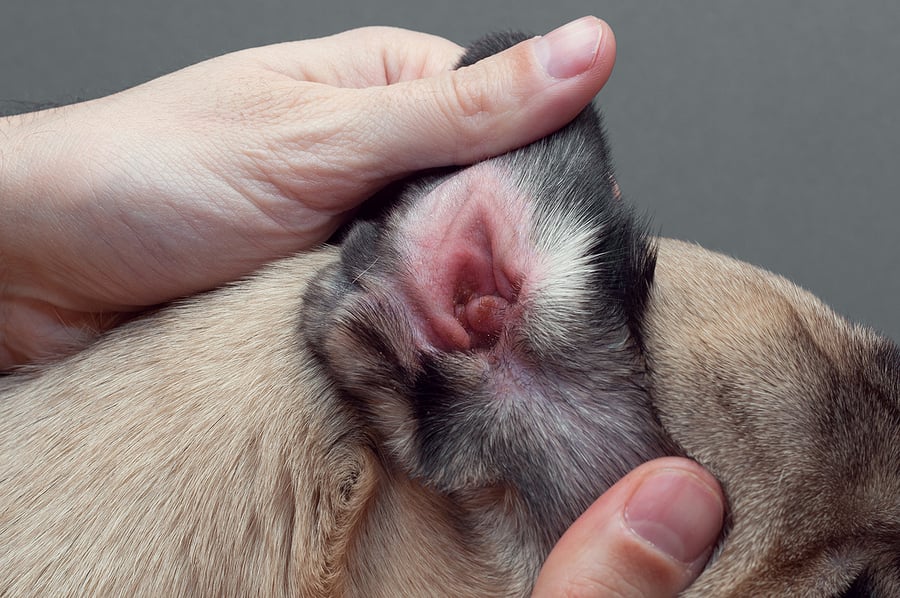
Have you ever flipped up your dog’s ear one day and discovered that it looks red and irritated? Or perhaps she suddenly started scratching one or both of her ears, maybe even rubbing her head on the carpet.
Inflamed ears are really uncomfortable for dogs. Even if your pup doesn’t appear greatly affected, some pups are really stoic and may not show signs of a problem until it’s been going on for a few days.
There can be many causes of a red, itchy ear. In this article, we’re going to review what some of those causes are, how to recognize a problem, and when to take your pup to see the vet.
What’s Causing That Red, Itchy Ear?
In a majority of cases, at least by the time it’s recognized, a red itchy ear is being caused by an ear infection.
But in a dog, ear infections are often just a complication of another underlying cause. This is typically due to an underlying allergy response.
But while the term “allergy” is used quite often, this underlying cause of ear infections and skin infections in dogs is really quite a bit more complicated than some seasonal sniffles.
To understand what happens, it’s important to briefly understand how important a role the skin really plays, especially in dogs. Many don’t think of the skin as an actual organ, but it really is and has many important roles as a protective barrier against infectious organisms and allergens.
Bacteria and yeast live normally on the skin, including the surfaces of ears in dogs. People too, have bacteria that normally live quite peacefully in harmony with us on our outermost layer.
But our symbiotic organisms live on our skin with restrictions because the skin barrier still keeps them in check, preventing overgrowth. In turn, the presence of these organisms keep more harmful ones from setting up shop.
But if there’s any changes to that important barrier the skin provides, all bets are off. We can see invasion and overgrowth of not just harmful bacteria that the skin comes in contact with, but even the normal, symbiotic bacteria and yeast can start to cause problems.
And this is essentially what happens with skin allergies in dogs. Many dogs are exposed to allergens everyday with no ill result. But in some dogs, their immune systems seek out and attack certain allergens. This sets off a complex inflammatory response that leads to breakages in that important skin barrier.
Because of how complex this process is, skin allergies in dogs should be thought of more as the condition called eczema in people. The most common form of eczema in people is called atopic dermatitis, which is exactly the same medical term we use for skin allergies in dogs.
In both dogs and people, atopic dermatitis involves the immune system responding to allergens, whether environmental or food-related, which in turn causes red, irritated and itchy skin. In dogs, we commonly see secondary skin and ear infections as a result of this break-down in the skin barrier. Most of the time, these infections are composed of the symbiotic yeast and bacteria overgrowing, but other more harmful bacteria sometimes like to join the party and make things worse.
Now, sometimes a pooch’s ear will become red and itchy just because of that allergen response but without an infection developing. But the only way to accurately tell the difference is for a vet to examine samples of the ears and see if growth is present or not.
How to Recognize a Problem
The best way to recognize a problem with your pup’s ears is to be on the lookout for it. Always try to take a look at your pup’s ears once a week, especially during higher risk times for allergy flare-ups, like the late spring, summer, and early fall.
What should you be on the lookout for? We’ve established that the ear can be red. And itchy. But there’s some other things to be on the lookout for as well.
Ears can have a normal type of waxy debris, which is called cerumen. But cerumen is typically present in modest amounts in an otherwise healthy-looking ear.
Ear infections are typically accompanied by an excessive build-up of debris, often brown or black, but it can also take on other colors like grey or tan. Seeing an abnormal amount of debris build-up on top of signs of redness and itchiness denotes a problem.
The odor of an ear will also change when an infection is present. Fungal yeast infections, for example, have a characteristic sweet musty odor.
There are some other changes you might see on the skin surface of the ear that denotes a serious problem too. This can include crusting and scaling of the skin, which is more common with bacterial infections. The skin may also take on a thickened, pebbly appearance.
Seeing two or more of these types of changes warrant a visit to your vet to see if an infection is truly present, find out what type it is, and to develop a treatment and prevention plan.
Are There Other Causes?
Before we get into how to address allergies and ear infections, let’s briefly review some other causes of ear inflammation that you might encounter.
Injury
Naturally, if the ear sustains some kind of injury, you’re going to see inflammation. The most common type of injury to the ears that we see in a vet practice are bite wounds, typically inflicted by another dog. This is also typically not something that’s subtle or goes unnoticed. Even small puncture wounds should be checked out by your vet, to help avoid infections or complications.
Ear Hematoma
If you take a look at your pup’s ear and it looks kind of like a small water balloon, chances are, you’re dealing with an ear hematoma. There are two layers of cartilage inside the ear that kind of stick together. If the ear experiences a trauma that causes the small capillaries inside the ear to bleed, it forces these layers of cartilage apart, allowing the ear to swell and fill with blood.
You can kind of think of it as a big bruise inside the ear. While this can certainly happen with an injury to the ear, like a bite wound, the most common cause is actually–you guessed it–an ear infection. The irritation and itchiness of an ear infection leads some dogs to shake their heads so violently that this actually bursts the capillaries in the ear.
There are about a dozen ways to address an ear hematoma and they can be frustrating, often taking weeks to fully heal, on top of treating the underlying ear infection that’s often present. Sometimes surgery is required to suture the two cartilage layers back together while leaving an open hole to drain on its own.
Allergic Reactions
This is different from the skin allergies that cause ear infections that we’ve discussed already. What we’re talking about here is something like a bee sting, contact allergy, or other hypersensitivity reaction that causes localized swelling or hives.
Usually, this is accompanied by a sudden irritation or scratching at the affected area. Any kind of sudden swelling or redness should be looked at by a vet. Allergic reactions to an insect bite or sting can start out local, but can quickly escalate to involve the entire body.
Other Causes
There can be a few other causes of ear abnormalities that can range from inflammation to crusting and bleeding. Parasitic infections, like the one caused by the scabies mite can cause a crusting and hair loss along the margins of the ear which is typically extremely itchy.
There are also some immune-mediated diseases–diseases where a dog’s own immune system attacks certain parts of the body–that can cause abnormal changes to the appearance of the ear as well. These diseases, like discoid lupus erythematosus, are fortunately pretty rare.
Some of these less common causes can be tough to lock down, because they can look like far more common things. Diagnosing them can take some time and patience.

Caring for Ears at Home
Now that you know what to look for, here’s some tips on how to keep up on your pooch’s ears at home.
Keep an Eye on the Ears
As stated earlier, the first and foremost part of caring for your pup’s ears is to be on the lookout for problems so they can be caught early.
Generally if you have a pup with a history or higher risk of inflammatory ear conditions or infections, but there is no current infection right now, cleaning the ears once a week is a good habit to form. This helps prevent debris accumulation and allows a regular good look to catch a problem before it goes too far.
Cleaning at Home
Regular ear cleaning can be very helpful, even if your pup isn’t showing signs of an issue. You don’t need to do it too often, but once a week is a reasonable interval when there’s no signs of infection present.
An early infection might just look like inflammation or it might be combined with some mild debris. Especially if you’re noticing a little scratching or head shaking, it’s safe in most cases to start with some daily cleaning to see if you can get ahead of it.
It’s important to use the right type of product. Using home-made solutions like pure vinegar, hydrogen peroxide, rubbing alcohol, and tap water, should be avoided. These solutions can be irritating to the sensitive ear canal. Water may just sit in the ear canal and make an early infection worse.
The best products to use contain either drying agents, like 2% salicylic acid, or an agent that breaks up ear wax and debris, like squalene. If your pup has a history of ear infections, it can be a good idea to keep a cleaner on hand that’s safe to use in case the eardrum may be compromised. Some products that are safe and effective to use include squalene products, trizEDTA products, and 1-2% acetic acid solutions.
When using an ear cleaner, squirt a generous amount down into the ear canal, massage the base of the ear until you hear a really satisfying squelching sound. This helps to break up debris stuck to the ear canal wall. Then allow your pup to shake his head, which further loosens debris. Finally, using a cotton ball or pad, wipe out the visible debris you can get to.
I generally discourage the use of cotton swabs, like Q-tips, at home. Pushing a cotton swab too deep into the ear can cause more trauma and possibly rupture the eardrum.
Although ear cleaning can be uncomfortable and sometimes stressful for both you and your pup, try your best to make it a positive experience. Always make sure to use firm but calm words, take it slow, and provide treat rewards before, during, and after.
For Recurrently Red, Itchy Ears
If you have a pup that truly just has inflamed, itchy, red ears, and perhaps an underlying allergy condition, but no infection develops (or has yet), a product I find to be very helpful is Zymox.
Zymox contains a small amount of hydrocortisone as well as some enzymatic agents. This combination can help to stamp out and prevent that early flare-up of red, itchy ears before bacteria and yeast have an opportunity to readily overgrow.
If your pup does have an allergy condition and it only manifests as ear inflammation but other areas like the skin and feet are unaffected, Zymox can sometimes be used successfully as a maintenance product a couple times a week during allergy season flare-ups.
When to See Your Vet
If your dog’s ear suddenly looks red and inflamed with itching and scratching and if it’s not something you’ve seen with her before, a visit to your vet is in order. It’s important to find out if an infection is starting, or otherwise what the underlying issue is.
If your pooch has has recurrent episodes of ear inflammation that you’re familiar with, it’s important to know if it’s getting out of hand and when to seek help. When treated effectively, ear inflammation, as well as ear infections, typically start improving in just 2-3 days. If your own methods at home aren’t showing steady improvement in that time, it’s time to seek help.
If there’s any suspicion an infection is present, meaning you’re seeing not just redness but debris, crusting, and especially if the ear is painful, it’s too late for at-home care to make a significant difference.

What to Expect at the Vet
So, your pup has that red ear. Maybe it’s crusty, smelly, and ouchy too. So you’ve brought her to your vet. What happens next?
Getting a Good Look
The first thing your vet will do is a full physical exam, including a careful look at both ears. Using the otoscope, the ear canal will be examined thoroughly, which includes looking at the eardrum. However, if the ear is extremely painful or swollen, this may not be possible.
Collecting Ear Samples
The next thing we often do is collect swab samples from the ear canals and take a look at them under the microscope. This helps us see if growth is present in each ear, what type it is, and how much there is.
This step is pretty important every time. There are cases where I think there might be growth present based on the appearance of the ear, and it turns out there isn’t. The opposite can also be true. Finding out the situation for sure leads to the best treatment plan. If there’s no infection, over the counter Zymox might be all we need. But if there’s a lot of growth present, a prescription medication will be required.
Cytologies are also important for knowing how successful a treatment course is, which is why it’s important to get new samples at each recheck visit. Even if an ear looks visually normal after a course of treatment, it’s still important to collect that recheck sample, as microscopic levels of growth may still be present that need to be treated a little longer.
If you stop treating too early based on visual improvement alone, you might see the infection come back full force in a couple more weeks.
Medication Plan
Based on how things look, including microscopic findings, your vet will then choose an ear medication and cleaner to use and a plan to follow. I typically prefer daily at-home medication use coupled with regular cleanings every couple of days.
However, some dogs and their parents have a hard time with this. It may even affect their relationship, as ear cleaning and medicating can be frustrating and difficult for some. In this case, there are leave-in medications that many vet practices have available, which may last anywhere from one week up to 4 weeks.
Ear Cleaning
While discussing the medication plan with you, your vet may have your pup’s ears cleaned at the clinic if there is debris present, especially far down in the ear canal. Veterinary staff are best trained to get cotton swabs deeper into the ear canal for a more thorough but safe cleaning.
Addressing the Root Cause: Allergy Medications
Since most inflammatory ear conditions are related to allergies and allergies can be chronic, topical ear medications alone may not be effective. So what else do we consider using?
The first thought for many pet parents is to try an antihistamine. Because antihistamines are an integral part of therapy for human allergies, it’s logical to think that they might work for skin allergies in pets.
While we sometimes employ antihistamines and they are cheap and readily available, they’re not very effective for skin allergies in dogs. Histamine just isn’t a big player, and only about ¼ of dogs are reported to see an improvement with antihistamine use.
If you remember, skin allergies in dogs are more like eczema in people, with atopic dermatitis being the proper term for both. So how is atopic dermatitis treated? By telling the immune system to back off.
There are a few medication strategies that can be employed to fend off the immune response to allergens that causes red and irritated skin and ears. Steroids are a first line treatment for the short term. There is nothing better to calm down irritated skin.
Unfortunately, oral steroids cause several undesirable side effects like excessive thirst (and excessive peeing), appetite, and panting. Most pet parents have a low tolerance for steroids after about one week, so while they work well in the short term, they’re not a good long-term solution.
Traditionally, since steroids aren’t a good long-term choice, veterinarians turned to broad-spectrum immunosuppressant medications to keep the allergy response at bay. Cyclosporine was the most common. They still have their place to be sure, but since they didn’t only focus on the skin, but affected the whole body, we had to be very careful about their use.
In the last few years there are newer medications that have been a real breakthrough for skin allergies, because they only target the immune response to allergens in the skin and spare the rest of the body. More specifically, they target components of the itch cycle called cytokines.
The first is oclacitinib, or Apoquel, which targets JAK 1 and JAK 3, two proteins that skin inflammation cytokines rely on. It’s an oral tablet that can start working within just a couple of hours.
The second is an injectable medication called lokivetmab, or Cytopoint. Cytopoint targets interleukin-31, which is an inflammatory cytokine that leads directly to the skin becoming red and inflamed. It can last anywhere from 4 weeks up to 8 weeks in some cases and starts working within 24 hours.
Which of these to consider can depend on a lot of factors, all of which should be discussed thoroughly with your own pup’s doc. Some pets just respond much better to one vs. the other. Dogs who don’t take pills well may do better with Cytopoint. Apoquel is better in conjunction with dietary food trials for allergies, since it can be stopped and started practically on a dime.
The final treatment choice we have for skin allergies is to pursue allergy testing and from those results, craft a therapeutic incorporating small amounts of those allergens to desensitize the body to them. This is kind of like an allergy vaccine.
While there are blood tests that can be sent out through a local vet, my preference is to have skin allergy testing done with a veterinary dermatologist, as I think they’re more accurate. The only downside to this therapy option is that it does take a few months, sometimes up to 6-10 months, to see results. This means you have to use another medication strategy in the meantime.

How Food is Related
While environmental allergies are most often the cause of skin inflammation, food can also be related too with a condition called a cutaneous adverse food reaction.
While we commonly refer to this as a “food allergy”, the exact mechanism that causes this response in the skin is not fully understood. It’s thought by many that the body responds adversely to certain proteins in the diet. Meat proteins are the most commonly implicated, like chicken or beef.
A strict diet trial is really the best way to determine if a food allergy is related. This constitutes a strict diet, usually with a prescription food, for 6-8 weeks. If signs of skin and ear problems lessen, what’s called a “challenge” can then be performed, where an old protein type is reintroduced. If this causes a flare-up, the offending protein has then been determined. Food trials require patience and persistence, as any deviation from the strict diet will necessitate starting over again.
There are multiple diet options, so make sure to speak with your vet about the best place to start for your pup.
Bringing Relief to the Redness
It’s important to determine the underlying cause of any inflammatory condition of the ears to know best how to treat it and manage it.
This can sometimes be challenging, and chronic issues with ears can lead to a big rift in the bond pet parents share with their furry friends.
But having a good relationship with your vet can make a big difference by helping you determine and understand the underlying cause, know what to expect, and help with management.
About Us
We've taken the guesswork out of caring for your pets. Our formulations are created by experienced veterinarians to address specific solutions for a variety of pet issues.
All of our products are:
As seen on:











